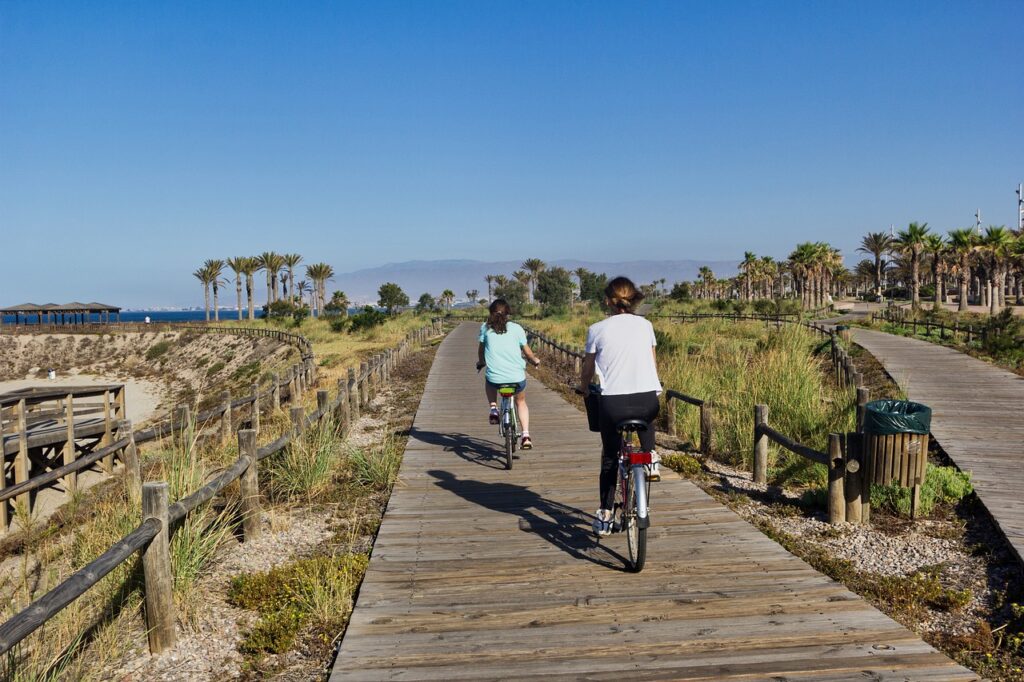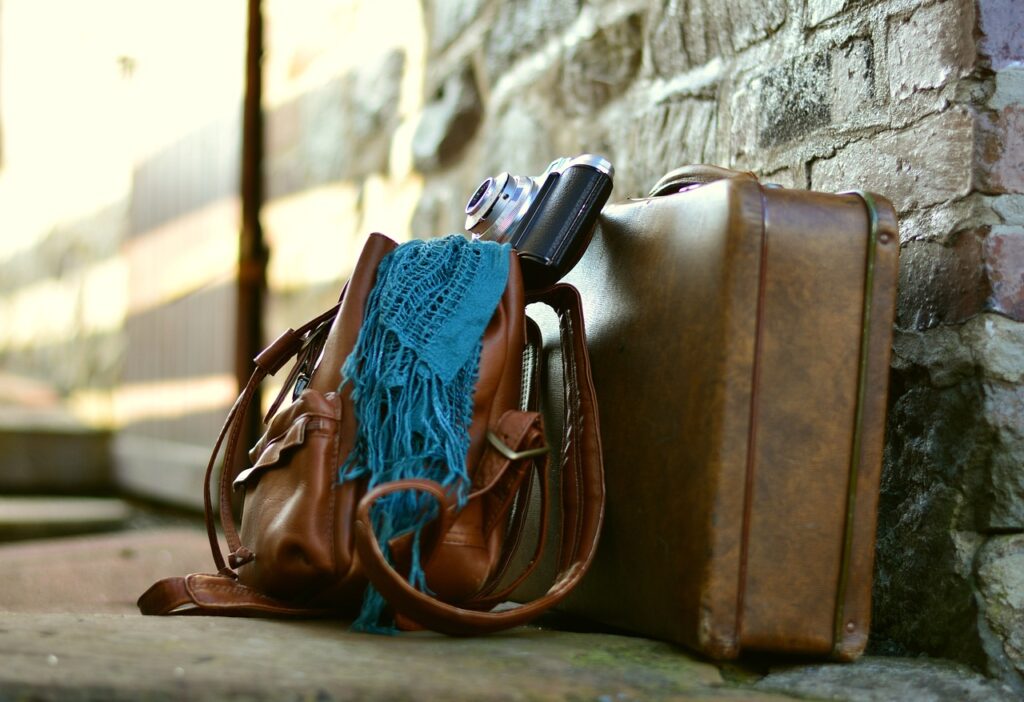12 eco-friendly travel tips to help you see the world while staying green!
Traveling is one of the best ways to develop a wider perspective, to try out new things and to reconnect to yourself, your family, and the world around you. But between plane emissions, single-use plastic toiletries, and the environmental degradation at favorite tourist hotspots, travel isn’t always the most eco-friendly choice.
Staycations are one way to stay green while on vacation, but if you still dream of seeing the world, there are ways to travel abroad in a more sustainable way. In the list below, you’ll find some of my favorite green travel tips, plus a few eco-friendly swaps that will help you reduce your impact while traveling to any destination.
Affiliate disclosure: As an Amazon Associate, I may earn commissions from qualifying purchases.

1. Take the road less traveled.
Popular tourist destinations see more than their fair share of visitors and the excessive foot traffic and pollution left behind by travelers can take their toll on local ecosystems and communities. Not to mention, these tourists hotspots are often overcrowded and hotels and tours can be expensive for travelers due to the increased demand for rooms and other necessities.
Instead of traveling to the hottest tourist destination this year, consider traveling to places that don’t see as many visitors. These locations will usually have better rates for you, but you’ll also help support small communities and take some of the burden off high traffic tourist destinations. Who knows what local treasures you’ll find off the beaten path!

2. Avoid peak season travel.
If you still want to travel to a popular destination, consider traveling at a time of the year when other travelers are less likely to be abroad. Winter is often a good time to travel to many destinations if you don’t mind the cold. If you don’t have children, you can also think about traveling during the school year when fewer people will be vacationing.
Traveling outside of peak season is a great way to save money, but it can also take some of the pressure off of popular travel destinations. For instance, hiking trails and historic gardens can develop a lot of wear and tear due to heavy foot traffic and other human activities. But when you travel outside of peak season, there will be less pressure on these environments and they’ll have more time to recover in between visitors.

3. Try slow traveling.
Traveling is about getting to experience a different way of life, so take your time as you travel and don’t try to rush around and check everything off a lengthy vacation checklist. Not only will this give you more time to appreciate the small things during your vacation, but it will also reduce your impact. Travelling slow and sticking to a single destination rather than city-hopping can limit transportation, reduce fuel use, and make trips even more meaningful.

4. Skip complimentary, single-use items.
While it can be tempting to accept that offer of “free airplane earbuds” or those cute complimentary hotel shampoos and lotions, skip these products if you can. Complimentary goods at hotels typically come in single-use plastic containers and this can cause a lot of unexpected waste. Of course, if you NEED that shampoo, you need that shampoo, but if you brought your own bottle of shampoo, consider leaving that complimentary bottle of hotel shampoo for the next person.
Tip: If you do use complimentary toiletries, take unfinished bottles of shampoo, conditioner, and lotion with you so they don’t go to waste!

5. Bring reusables.
If you’re committed to sustainable living at home, there’s no reason why you can’t bring some of your sustainable must-haves on your vacation with you. This will help you avoid single-use plastic travel goodies, but it can also help you save money on your trip.
What reusables you’ll need will depend on where you’re traveling to and how much you can pack in your luggage. However, some reusables you may want to consider bringing include:
- Reusable shopping bags. You’ll need somewhere to carry your souvenirs, right? You can also save money while travelling by shopping at local grocery stores and cooking your foodie finds in your hotel room!
- Reusable cutlery. You can picnic on the go!
- Reusable water bottle. One of my favorite travel finds of all time are collapsible water bottles. They pack up super slim in luggage, can fit into most purses (when empty), and they hold lots of water too!
- TSA-compliant refillable shampoo and conditioner bottles. These handy refillable bottles can be used to tote around your favorite shampoos, lotions, and conditioners from home. Or you can bring solid shampoo bars or conditioner bars that are liquid-free and plastic-free too!

6. Use what you have.
Many travelers run out and buy a lot of new clothing and other goodies to bring on their trip. But the most eco-friendly items you can bring on vacation are the items you already own!
Before heading out to buy a new suitcase or outfit for your vacation, take a look in your closet. You may be surprised by what you find there!

7. Invest in sustainable travel staples.
If you do determine that you need to purchase new items for your vacation, look for products made by eco-friendly companies and items that are made with sustainable materials. For example, clothing made from organic cotton, hemp, or untreated wool (not superwash wool) is much greener than clothing made from synthetic fabrics like polyester. And if you’re going to a sunny locale, try out reef-safe sunscreen, which is free from UV-blocking chemicals (like octinoxate and oxybenzone) that contribute to coral bleaching.
Tip: When in doubt, leave the extra outfit at home. Packing lighter can help cut fuel usage on flights!

8. Choose eco-friendly businesses.
Flights are one of the least sustainable parts of traveling, but you can reduce your impact by flying with airlines that are committed to more sustainable practices, like using biofuels. Some hotels and motels also have sustainability pledges and they take other actions to keep their rooms more environmentally friendly. Hostels and locally-owned Airbnbs are often even more green than the average hotel since they use less water, electricity and heat per guest.
Tip: Non-stop direct flights use significantly less fuel than flights with layovers because they only need to take off and land once!

9. Conserve water and electricity.
When you’re not in your hotel room, be sure to flip off the TV and turn off the lights to conserve electricity. Hanging up your towel after you use it and putting out that “Do Not Disturb” sign will also signal to housekeepers that you don’t need to have your towels and sheets laundered every day, which can cut electricity and water waste. For extra green “bonus points,” return informational brochures after you use them so tour companies and other tourist attractions won’t need to print as many and waste paper!

10. Take public transport.
Taking the bus or the train or carpooling can slash fuel use while you’re commuting at home… but those same principles hold true while you’re abroad. If you’re planning to stay in one city during your trip, skip the rental car and check out the local bus schedule instead. If you do need to rent a car, look for models that get good mileage and select electric car options whenever you can.

11. Stay on the path.
Heavy foot traffic can decimate plants, tear up walking paths and lead to erosion and other problems. If you plan to hike on your vacation (or you’re just considering taking a shortcut through a garden), be sure to respect local signage and stay on designated trails. Being considerate of local customs, rules, people, and places is an essential part of conscious traveling!

12. Leave no trace.
Whether your travels take you to the city or the country, always be sure to take what you bring with you when you leave. Remember: litter is litter no matter where you go! Bringing your own reusables and a water bottle with you will help you reduce waste too.

Frequently Asked Questions About Sustainable Tourism
What is the most sustainable way to travel?
Trains are one of the most eco-friendly ways to travel between cities. When you’re traveling within a city, take a walking tour or travel by bike to keep your trip as green as possible!
What is the least environmentally friendly way to travel?
While planes have a bad reputation for using up a lot of fuel, cruise ships can actually emit over 9 times as much carbon per person as flying!
How do you pack really lightly?
Staple clothing items in neutral shades can keep your packing list short since these clothes can be mixed and matched easily to create tons of outfits. Traveling with just one or two pairs of comfy and versatile shoes can also keep your luggage light!





